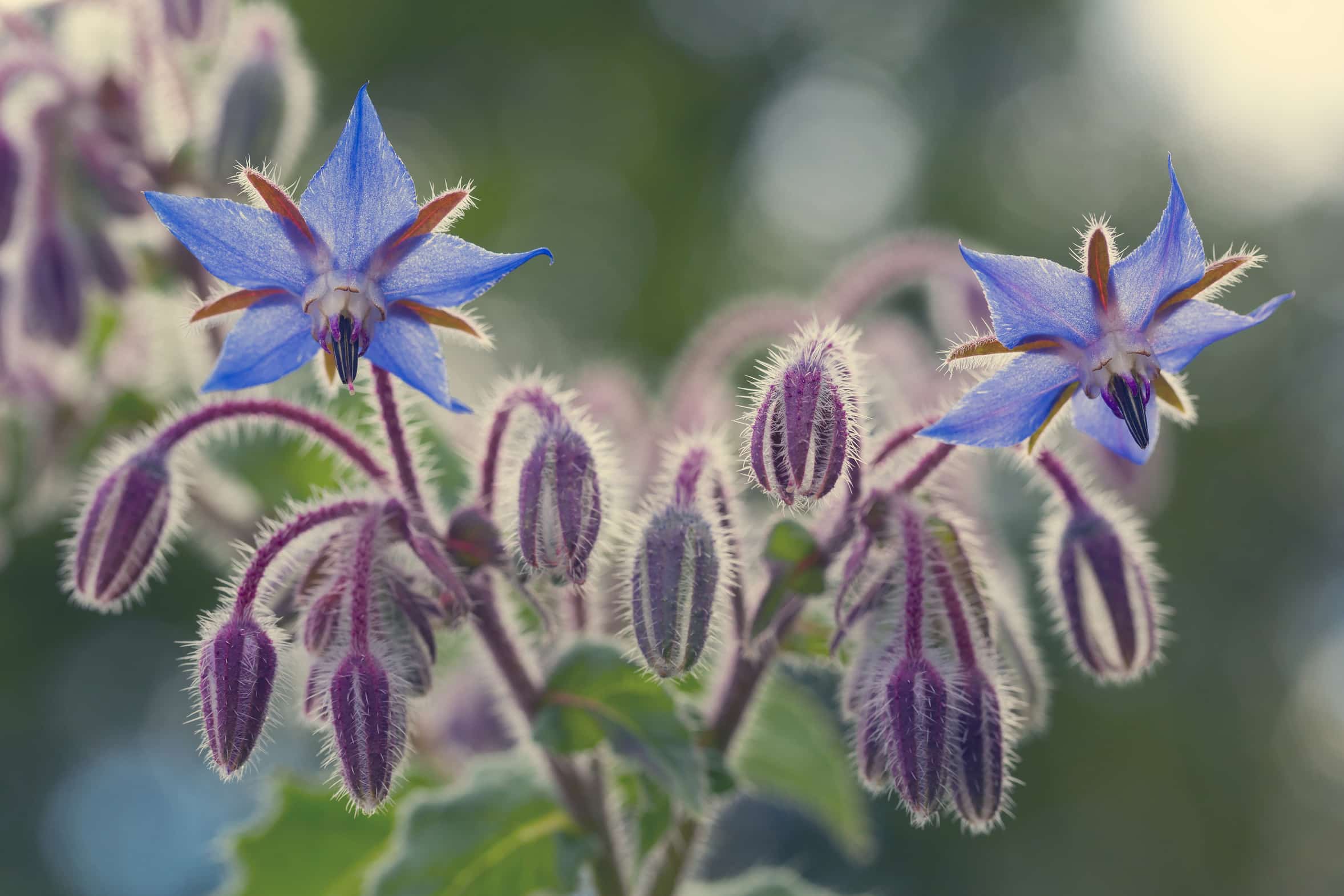Borage Seed Oil

Borage is an annual plant of the Boraginaceae family, also known colloquially as cucumber herb. It originated in the Mediterranean region, but is now also cultivated in Western Asia, the United States and the warmer regions of Europe. Borage seed oil or Borago Officinalis (Borage) Seed Oil is extracted from the tiny seeds of the plant. Basically, the borage plant finds use in medicinal medicine. As a result, its oil finds numerous applications within cosmetics and medicine.
Borage seed oil and its ingredients
The production of oil from the borage plant can be done in two ways. Firstly, the cold pressing of the seeds produces the borage seed oil with its valuable components. Furthermore, the oil can be obtained by extraction and subsequent refining. In this process, however, less valuable ingredients are retained. Borago Officinalis Seed Oil has a variety of health-promoting components. Thus, γ-linolenic acid, linoleic acid, palmitic acid, stearic acid, oleic acid, tocopherols, flavonoids, mucilage, and tannins, saponins are important components of the oil. It is the oil with the absolute highest content of γ-linolenic acid and proved in studies that it has a good effect against inflammatory skin diseases and especially against neurodermatitis. Borago Officinalis Seed Oil has an anti-inflammatory effect and at the same time promotes the immune system.
Possible applications in a medical context
The polyunsaturated fatty acids of Borage seed oil have a positive and balancing effect on hormone balance. By taking it internally, a disturbed hormonal balance can be restored in many cases. This internal intake is usually done as a course of treatment. Omega-3 and omega-6 fats are abundant in the oil. These fats are said to have a positive effect on the cardiovascular system.
When taken internally, side effects may occur only in exceptional cases, which is usually not the case with external use. Such side effects include mild gastrointestinal discomfort and a negative effect on the course of the disease in manic-depressive individuals.
Borage seed oil in cosmetics
In cosmetic products, the Borage seed oil is considered a valuable ingredient. The contained γ-linolenic acid is a component of the epidermal skin barrier. Due to this, the oil is excellent for mature skin and can contribute to skin rejuvenation with its skin regenerating properties. Borago Officinalis Seed Oil stimulates the activity of skin cells, regulates sebaceous gland production, and restores skin elasticity. Thanks to its firming properties, it is also an ideal ingredient for sports oils and cellulite products. However, it is recommended to use a ready-to-use preparation for external application, as this is the only way to ensure a constant content of the ingredients that determine its effectiveness.
Borage seed oil is used in the treatment of neurodermatitis and psoriasis. Its anti-inflammatory and antipruritic properties have positive effects on the symptoms of sufferers. The application of Borage seed oil in neurodermatitis patients ensures that the inflammatory skin changes are significantly alleviated and recede. The gamma-linolenic acid is responsible for this, as the skin can regenerate more easily with its own substances. The content of gamma-linolenic acid is about 21 percent, while evening primrose oil contains only 3.0 percent of this substance.
Basically, the oil can be used for neurodermatitis, atopic dermatitis, psoriasis, itchy, dry as well as scaly skin, during pregnancy and breastfeeding to support and improve the regeneration of the skin.
Fact Sheet: Borage Seed Oil
INCI: Borago Officinalis (Borage) Seed Oil
Melting point: 20 degrees Celsius
Saponification number: 184 – 194
Oil group: W-2
Iodine value: 130 – 150
Main constituents: gamma-linolenic acid, palmitic acid, oleic acid, stearic acid, linoleic acid, erucic acid
Important: At less than five percent, erucic acid, which is considered nutritionally critical, is below the legal limit relevant for food oils. For cosmetic use, this value has no significance anyway.
Borage seed oil : More than just a cucumber herb
Borago Officinalis Seed Oil, is an incredibly versatile and valuable oil that has a positive and beneficial effect on the skin due to its immensely high content of gamma-linolenic acid. The ancient spice plant, whose flowers bloom all summer long in a magnificent blue-violet, thus gives us a raw material that supports health and beauty in a natural and gentle way. Borage seed oil can be used both internally and externally and is becoming increasingly popular as a therapeutic agent for atopic and barrier-disrupted skin. Are you interested in high-quality cosmetic formulations with the oil of the borage plant? We will be happy to help you.
Sources:
Omega-3 Versus Omega-6 Polyunsaturated Fatty Acids in the Prevention and Treatment of Inflammatory Skin Diseases.; Int J Mol Sci. 2020 Jan 23;21(3):741.
Antioxidant, Antimicrobial and Formulation of Borage (Borago officinalis) Seeds Oil and Leaves Extracts as Microemulsion.; Yaghmour R, Garajah M, Kayali I, Al-Rimawi F. J. Pharm. Res. Int. 2021; 33(55A): 136-148.
The new challenge of green cosmetics: natural food ingredients for cosmetic formulations.; Dini, I., Laneri, S. Molecules. 2021; 26(13), 3921.
A Randomized, Placebo-Controlled Trial of Gamma Linolenic Acid as an Add-on Therapy to Minocycline for the Treatment of Rosacea.; Ann Dermatol. 2020 Dec;32(6):466-472.
Anti-Inflammatory and Skin Barrier Repair Effects of Topical Application of Some Plant Oils.; Lin TK, Zhong L, Santiago JL. Int J Mol Sci. 2017 Dec 27;19(1):70.
Protective Effect of Borage Seed Oil and Gamma Linolenic Acid on DNA: In Vivo and In Vitro Studies.; Tasset-Cuevas I, Fernandez-Bedmar Z, Lozano-Baena MD, Campos-Sanchez J, de Haro-Bailon APLoS ONE. 2013 8(2): e56986.
Clinical effects of undershirts coated with borage oil on children with atopic dermatitis: a double-blind, placebo-controlled clinical trial.; Kanehara S, Ohtani T, Uede K, Furukawa F. J Dermatol. 2007 Dec;34(12):811-5.
